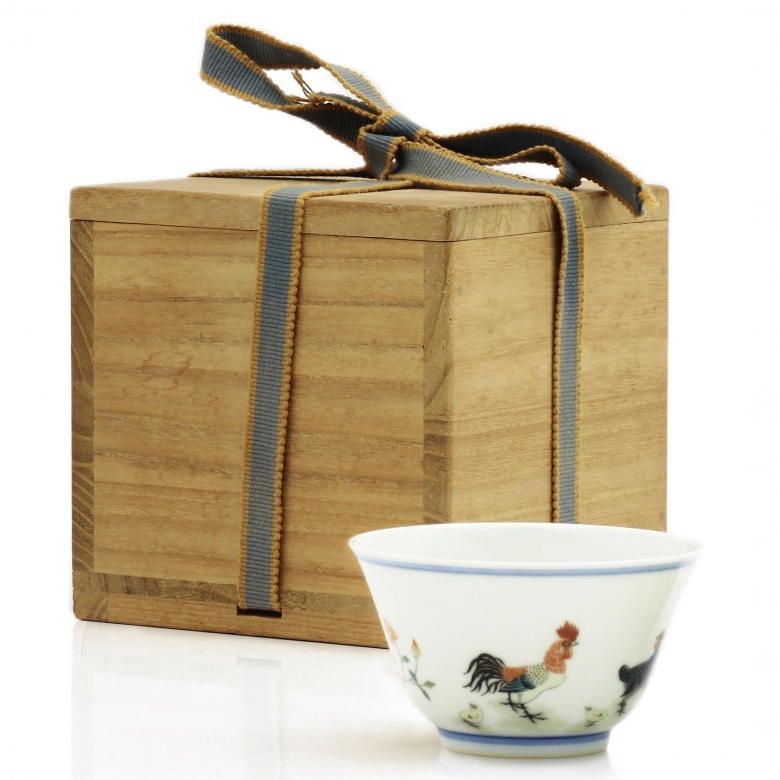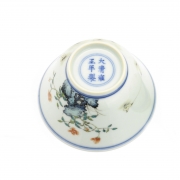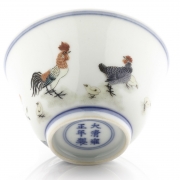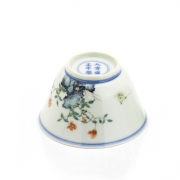LIVE AUCTION JUNE 24TH - 1st SESSION "ASIAN FINE ART"
Fine and rare Doucai "Chicken Cup", Yongzheng (1723-1735).
精美稀有的斗彩“鸡杯" ( 大淸雍正年製 ) 六字双行款. 出处: 1923 年購自富田熊作,為日本京都私人收藏。 目前的主人是一位重要的荷蘭收藏家,他於 2019 年在日本京都一位知名收藏家手中購買了這件作品,這位日本收藏家出於隱私原因要求不具名。藏品包含了100 年以上對古董的特殊出口許可證的申請。证明他於1923年從京都富田熊作處購得,詳情為 “雞杯1923”富田熊作” 屬於他1919年至1923年間的收藏品。需要注意的是,在日本如果偽造、欺騙或撒謊有關文件或古董和藝術品的銷售, 是会受到嚴格處罰法律。
富田熊作(Tomita Kumasaku 1872-1953)是兵庫縣米酒批發商的兒子。1897年富田熊作被大阪著名的艺术品经销商山中商会 Yamanaka&Co 聘请为伦敦分公司, 一直到1922年他回到日本、定居京都。 它以照明成化型製作而成,呈深邊U形。描繪了一隻母雞,一隻公雞和五隻小雞在開滿鮮花草丛上的图景,在后面藍色釉岩石上缀有綻放的红玫瑰花朵和郁郁葱葱的茂盛葉子,杯子唇部和底部帶有雙線邊框, 公雞的尾巴和一些細節是雍正時期最先开发出的有真正光泽,浓重黑亮的黑色琺瑯製成。使瓷器装潢师能以书法风格应用颜色,可以用于书法,也可以用于绘画树木,及岩石和公鸡的尾巴。这种新琺瑯及其赋予陶瓷艺术家自由的描繪 “雞杯”上的豐富性場景。
在底部青花雙圈內有六個字符的標記。款识“大淸雍正年製” “雞杯” 一詞,指的是塗有公雞,母雞和小雞的瓷酒杯,其凝蕴成化皇帝独有的美学思想,成化帝曾因观赏宋代子母鸡图感慨,母鸡护雏卫幼、抚育稚子是成化帝钟情子母鸡纹的一大源由。康熙,雍正君主均有慕古之心,更是把母鸡护雏喻为君主爱民如子等治国之道。曾谕旨御窑摹制,并各有化裁,自成一格,此个斗彩鸡杯即为其中之杰出代表。
精美稀有的斗彩“鸡杯”大淸雍正年製六字双行款 時期(1723-1735)
SIX-CHARACTER MARK (大淸雍正年製 ) IN UNDERGLAZE BLUE INSIDE A DOUBLE CIRCLE AND OF THE YONGZHENG PERIOD (1723-1735).
Modelled after the Ming Chenghua prototype, this cup has been potted forming a U-shape with deep sides. It rises over a circular base where a six-character reign marks (大淸雍正年製 ) is inscribed within a double circle, both details in underglaze blue.
Delicately painted in a Doucai style with characteristic soft enamels, this ‘chicken cup’ depicts a hen, a rooster and five chicks on a glassy bank with flowers. The reverse is covered with underglaze blue rocks which have been accentuated with red rose blooms and lush leaves. The lip and the foot present a double-line border, also in underglaze blue.
Diameter: 8.2 cm
Japanese wood box.
References:
Sotheby's, Hong Kong, April 5, 2017. Lot 3106 - Sold for: 12,100,000 HKD (1,557,149 USD)
Christie's, Hong Kong, June 3, 2015. Lot 3144 - Sold for: 9,040,000 HKD (1,164,370 USD)
Provenance:
Acquired in 1923 from Kumasaku Tomita, Kyoto.
The current owner is an important Dutch collector who bought the present piece in 2019 from a large and reputable collector in Kyoto, Japan, who for privacy reasons has asked not to be named. He very kindly provided us with the document of the purchase, made in Kyoto, which contains an application for a special export license for antique pieces over 100 years old. This clearly states that it was purchased by the Kyoto collector in 1923 from Kumasaku Tomita and details as "IMPERIAL CHICKEN CUPS YONGZHENG, 1923 Kumasaku Tomita". Indicating that it belonged to his collection between 1919 to 1923. It should be noted that in Japan it is strictly punishable by law to forge, mislead or lie about the documentation or sale of antiques and art.
Kumasaku Tomita (1872-1953) was the son of a rice wine wholesaler in Hyogo Prefecture. In 1897, Kumasaku Tomita was hired by the famous Osaka art dealer Yamanaka & Co for the London branch of the Chamber of Commerce. He soon became the manager of the company and ran the branch. During his time at the company, he acted as an organizer of important exhibitions such as the British Red Cross exhibition about Japanese art held in 1915. He was also a great collector of oriental pottery. In 1922 he returned to Japan and settled in Kyoto.
Notes:
The term ‘chicken cup’, which denotes a tiny porcelain wine cup painted with cocks, hens and chicks, has for centuries evoked one of the most desirable possessions for connoisseurs of Chinese works of art – imperial and otherwise. Emperor Chenghua related that this scene reflects how the current generation cares about the next. He even considered that the hen taking care of the chicks was a way of ruling the country.
A ‘chicken cup’ is not only celebrated as one of the finest and rarest specimens of Chinese ceramics – its materials, potting, painting and firing being of the highest quality. Praised and desired by Ming (1368-1644) and Qing (1644-1911) emperors, ‘chicken cups’ have acquired a legendary aura that goes well beyond their immediate art-historical importance and has placed them as the crowning glory of any collection of Chinese porcelain or any other discerning literati collectors.
In the case of the Kangxi ‘chicken cups’, the tails are painted in black enamel. However, this enamel was neither glossy nor stable. In order to prevent it from being rubbed off, the paint had to be covered in a clear pale green or purple enamel. This technique also provided depth and gloss. It was not until the Yongzheng reign that a true glossy black enamel was developed, allowing the porcelain decorators to apply the colour in calligraphic styles – both for calligraphy itself, and in the painting of trees, rocks and the tails of roosters. In an apparent celebration of this new enamel, and the freedom it gave to the ceramic artists, the tails of the roosters on the current ‘chicken cup’ have been redesigned to emphasise the richness, fluency and movement of the birds’ natural feathers.
* If you are a not a premium user at Darley Auctions you must pre-register to bid on the current lot. It is compulsory send the application at least two working days before the sale. To bid on this lot via Telephone or Online at any platform you must complete the registration process at least 24 ours prior to the sale. Darley Auctions reserve the rights to don't accept any application completed after the present deadline. For more detailed informationsk email info@subastasdarley.com.














































